#retellings
Text

How many ways can I draw this couple kissing? I found a ton of these while putting together my 2023 artvsartist grid. Way more than what's here, but these are the ones that I like, that have no background, and won't get me banned on social media haha
#beauty and the beast#ya fantasy#monster boyfriend#fairytale retelling#monster romance#fantasy illustration#retellings#book characters#ekbelsher
2K notes
·
View notes
Text
wait i think actually madeline miller's circe is the heir to margaret atwood's penelopiad, unintentionally, in the way it thematizes the impossibility of real solidarity among women.
bc it's such a major part of the penelopiad how penelope creates what she thinks is a real community, a sort of family, with these young women in her household only be to reminded and continue to reinforce that they are slaves over whom she (among others) holds the power of life and death. and penelope ultimately does not or cannot hold a lasting grudge against odysseus on their behalf. she aligns herself, or circumstances force her to align herself, with odysseus instead of with other women whose positions are even more dangerous than hers. the world they live in does not allow solidarity between women across lines of class and enslavement, and penelope is also complicit in maintaining that world and her place in it.
and then the thing i found so frustrating about circe was that at every turn miller forecloses the possibility of real connections between women-- but the thing in this world that prevents that is just, like, jealousy over men. and totally needlessly. the other nymphs are prettier. glaucus loves scylla and not circe. her mom never liked her. hermes doesn't really think she's hot. athena is a rival for odysseus' attention. and the book doesn't do anything with this, it's not due to structural power imbalances or a society built on enslavement or even how patriarchy pits women against each other (circe lives alone on an island outside of society that could be another writer's lesbian separatist utopia!), it's just that circe doesn't like other women and they don't like her. end of story.
much as i don't love what atwood does with helen, it does make sense in the context of the penelopiad! thematically and in terms of characterization. atwood's penelope has internalized this idea of what it means to be a good woman and, willingly or not, she's staked everything on being seen by men as a good woman. it makes sense that she's desperately trying to pull herself up or even just cling to what little she has by dragging other women down. she does to helen what she ultimately does to the maids. she's with and for odysseus, always, not helen, and not the maids. that's the kind of world she lives in, and while she likes to think that she's resisting it with a sort of radical female community, in the end she is its agent. even if she feels bad about it. she's here to tell a story about odysseus, not about the girls he killed.
#makes me think of how emily wilson translates φιλη Ευρυκλεια as 'the slave who loved her master' or something similiar#which is the same sort of characterization atwood gives eurycleia. an enslaved woman who puts her master above other slaves and other women#and on the one hand of course she does! that's how she survives! can you blame her?#she lives in a society that pushes her at every turn to betray her fellow enslaved women!#but on the other hand it's still sad and somehow you can blame her#mine#reception#retellings#i think i finally get the penelopiad now. after reading the novel twice and seeing the play three times.#long post
140 notes
·
View notes
Text


Some of the main characters from my Frankenstein retelling.
{When darkness shines}
Adam. (Victor Frankenstein’s creature)
Dew. (An original character created by me for a big role in the retelling, which includes being the love interest of Adam.)
Victor will be the next to introduce 👀
#artist#art#Retelling#retellings#Frankenstein#victor frankenstein#frankensteins monster#mary shelly's frankenstein#bride of frankenstein#classic#classic story#classical art#original character#original art#digital art#artists#fyp#fanart#fanarts#Frankenstein art#frankenstein's creature#Frankenstein fanart
76 notes
·
View notes
Text
There seems to be a pendulum-swing going on in how people view the myth of Hades and Persephone.
The way I learned the myth in my childhood, and I assume the way most of us did, Hades was the villain. Persephone was happy aboveground with her mother, and just as miserable down in the Underworld as Demeter was to lose her. She was tricked into eating the pomegranate seeds, not knowing that they would bind her to Hades, and the ending was bittersweet, as she happily reunited with her mother for part of every year, but for the rest of the year was forced to go back to her loveless marriage in the bleak Underworld.
This was the standard version of the myth I was taught.
But then, in more recent years, a backlash rose against portraying Hades as evil. I suspect it really took off after 1997, in response to his villainous portrayal in Disney's Hercules. People argued that the ancient Greeks didn't view Hades as evil, they worshipped him like all the other gods, and that modern portrayals of an evil Hades tend to conflate him too much with the Christian Satan. They extended this argument to the story of Persephone too, pointing out that Hades truly loved Persephone, that he had her father Zeus's permission to marry her, that by all accounts he was the most faithful husband of all the gods, and that Persephone gained power in the Underworld: she became its revered queen.
There was also a feminist push to give Persephone more "agency" and avoid ending the story with her remaining unhappily married to her kidnapper.
This led to the rise of retellings that romanticized Hades and Persephone's marriage. They emphasized that Hades's love was true, portrayed Persephone as genuinely falling in love with him and coming into her own power through their marriage, and portrayed her as choosing to eat the pomegranate seeds because she wanted to stay. It also became popular for these retellings to vilify Demeter, portraying her as a controlling, possessive mother who needed to learn to let Persephone grow up and leave the nest.
But now there's backlash against those retellings. People are pointing out the ugly implications of romanticizing a kidnapping and forced marriage and victim-blaming the kidnapped girl's distraught mother. They're arguing that the story was always meant as a tragedy with Demeter as the heroine and Hades as the villain. That it reflects the forced separation of mothers and daughters through arranged marriage in ancient Greek culture, and/or that it's about death and the loss of a loved one, and of course that it explains the seasons and why part of the year is bleak, cold, and infertile.
Are any of these interpretations the one true meaning of the myth? I doubt it. But it's interesting to see the pendulum swing.
618 notes
·
View notes
Text
“I think there are lives that make it easy to be good. Or what most people call good. When you have wealth, status, family, it’s easy to be a saint, it costs you nothing. I can’t say if you’re a good person or not. But the more I know of you, the more I understand that the world keeps making you choose between survival and martyrdom. No one should fault you for wanting to live.”
— Margaret Owen (Little Thieves | Little Thieves #1), first pub. 2021, USA
#Margaret Owen#Little Thieves#fantasy#magic#fairytales and folktales#retellings#romance#young adult#YAbooks#books#book quotes#quotebook#on life
93 notes
·
View notes
Text
I've seen a few different threads around over the last few days debating whether people are 'allowed'/whether they should keep reimagining the myth of Persephone's abduction, and it feels to me like these discussions are actually two different conversations that have been flattened into one. I am staunchly in favour of retellings and reimaginings. I may not always agree with what an adaptation etc. does, but ultimately I'm always enthusiastic about people engaging creatively with myths, legends and folklore. Not everyone feels this way, and a lot of people are fiercely protective over what they consider the "correct" version of a myth. Hence the common resurgence of debates like the one about reimagining the Persephone myth.
Thing is, you can be both enthusiastic and critical about retellings – indeed, sometimes you need to be critical of them. The Rape of Persephone is a really good example of this, actually. The version most children learn goes like this: Persephone is abducted because Hades has fallen in love with her; Demeter holds the fate of the human race hostage against Zeus until he agrees to send Hermes down to save Persephone from Hades; Persephone eats six pomegranate seeds, so she has to remain in the underworld for six months of the year. What's crucial here is that this popular, sanitised version reframes Persephone's plight as her fault. She is so beautiful that Hades can't resist her. She eats the seeds willingly. It's an ancient myth given a new facet, but it's a facet cut by modern misogyny* – and that's definitely something to criticise. In the Homeric hymn to Demeter, the oldest extant written record of the tale, Hades feeds Persephone the seed by force and deliberately conceals this act from Zeus. He knows it's wrong, and the audience knew it was wrong, and there isn't a reason why making the myth child-friendly had to involve cutting this part out.
Does that mean nobody should ever retell the myth? No! But we should definitely ask why this version has become so popular, and consider what it says about our contemporary society.
*Ancient Greek society was highly misogynistic too, make no mistake. Yet (male!) classical writers didn't pull their punches when it came to showing Persephone's distress and the horror of her situation.
99 notes
·
View notes
Text

Greeks are putting out books to clean up the misinformation Westerners have spread about our myths and I LOVE it.
Ioanna puts the focus on Demeter and I am here for it! Demeter is the protagonist of this story, after all.
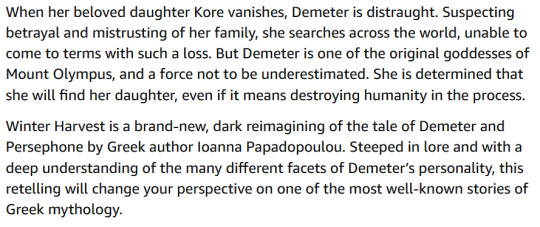
In the reviews so far it looks like Ioanna depicts the Greek gods as powerful, as we truly see them in our culture. I really hope it keeps the balance, as the reviewers say.
Greek author, Greek book cover illustrator (Yorgos "Lanthimos" Cotronis) and we are on for a very promising work!
source
#hades and persephone#hxp#retellings#persephone#greek mythology#greek gods#greek people#hellas#ioanna papadopoulou#books#reading#libraries#writing#writers#greek writers#demeter#goddess
268 notes
·
View notes
Note
Personal opinion but I find it ironic how many complain about wanting Greek myth retellings with complex characters, yet completely ignore that our mythology is already complex.
Like authors would claim they will retell a popular myth to give voice to a female character, as if the women in the myths didn't have already. It's just not in a way it's used in popular media.
The women in the OG myths aren't afraid to speak their mind and be true to what they believe, they are scared but also brave, they can be soft and shy, but also angry and bitter. Mothers, daughters, slaves, goddesses, all give equal time to shine and those stories still hold after thousands of years because they fell human.
What modern retellings offer? A same strategy for profit. All powerful, all perfect, no flaws, all righteous that ends up hollow and bland as a character and easily forgettable. 🤷🏻♀️
Agreed! And I don't think it's just for profit. How the Anglosphere engages with Greek myth hasn't stopped being colonialist and imperialist in nature, especially since those countries still have sway over Greece and our politics (the US is our Big Brother as I often mention). Without adequate reaserch, so many of them feel comfortable to assume they know better than these savage ancient/modern Greeks and they are so much smarter, and only they can portray these characters in a way that matters (aka through their country's modern lens).
54 notes
·
View notes
Text
I did it! The great endeavor I began, five years ago, to rewrite every Austen novel blended with a fairy tale is DONE. You can now reexperience all/moments of your favorite Austen moments, but now with elemental magic and cursed princes!
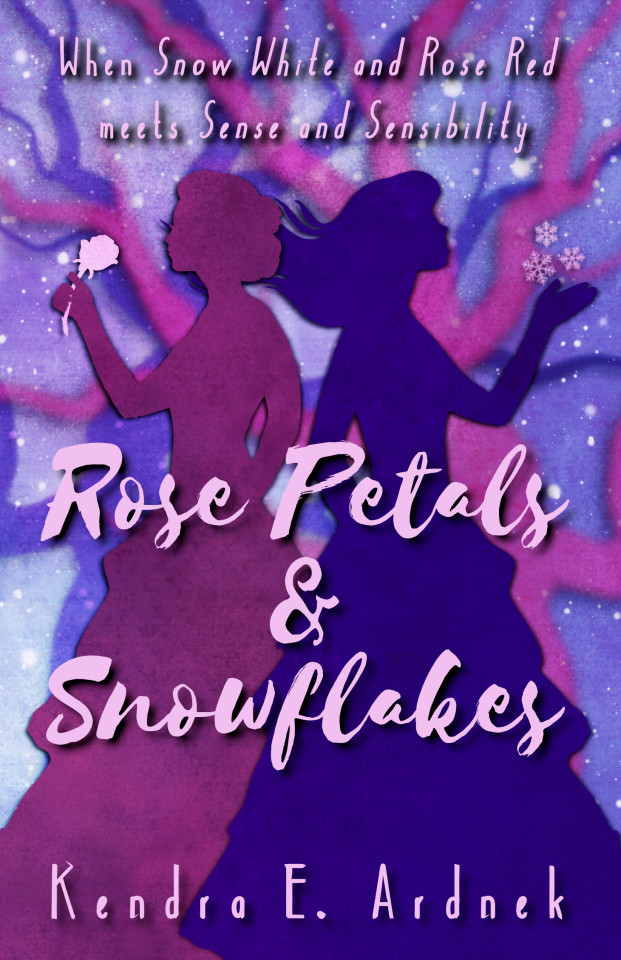


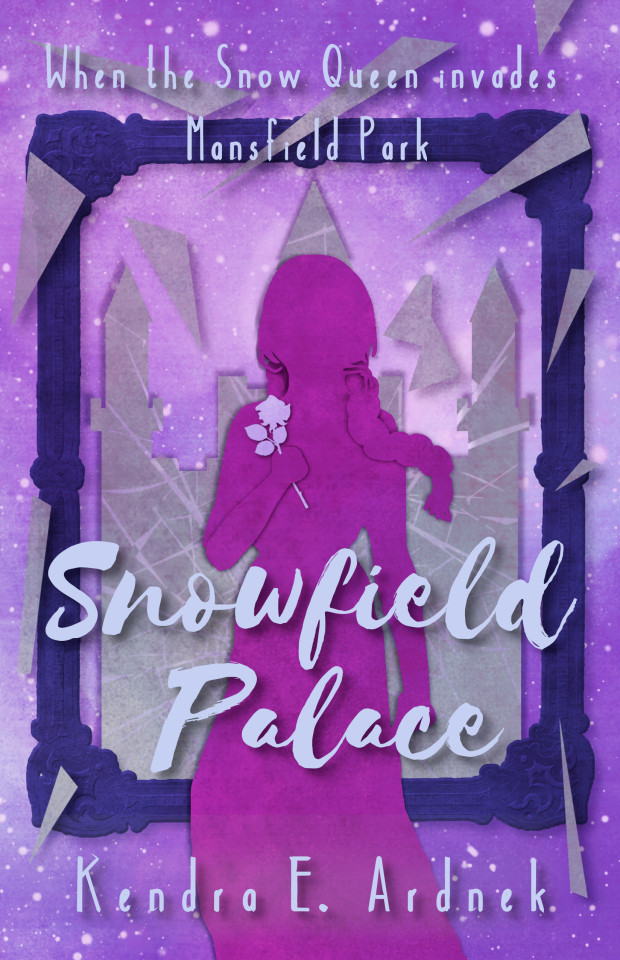
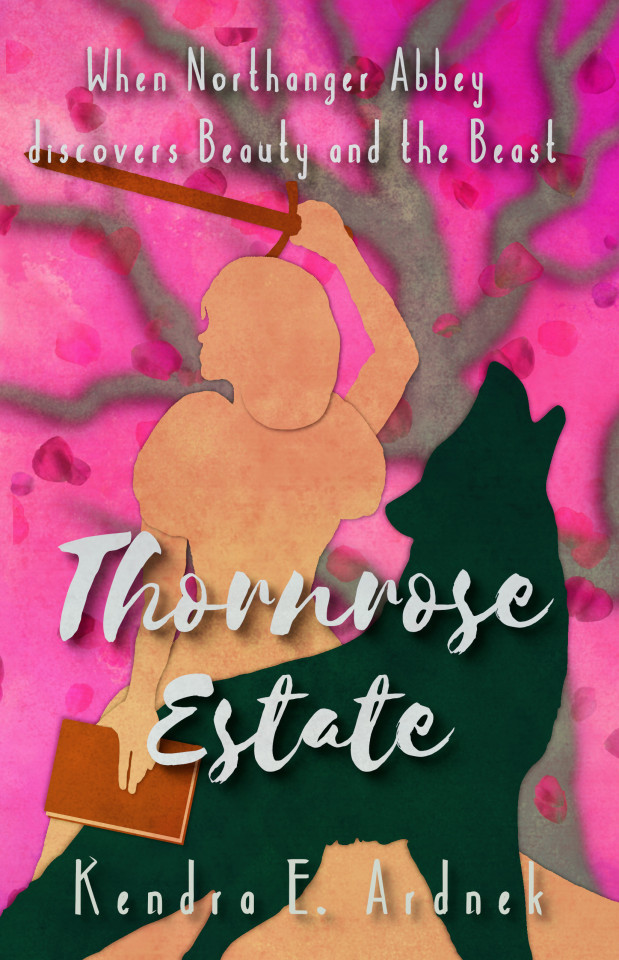
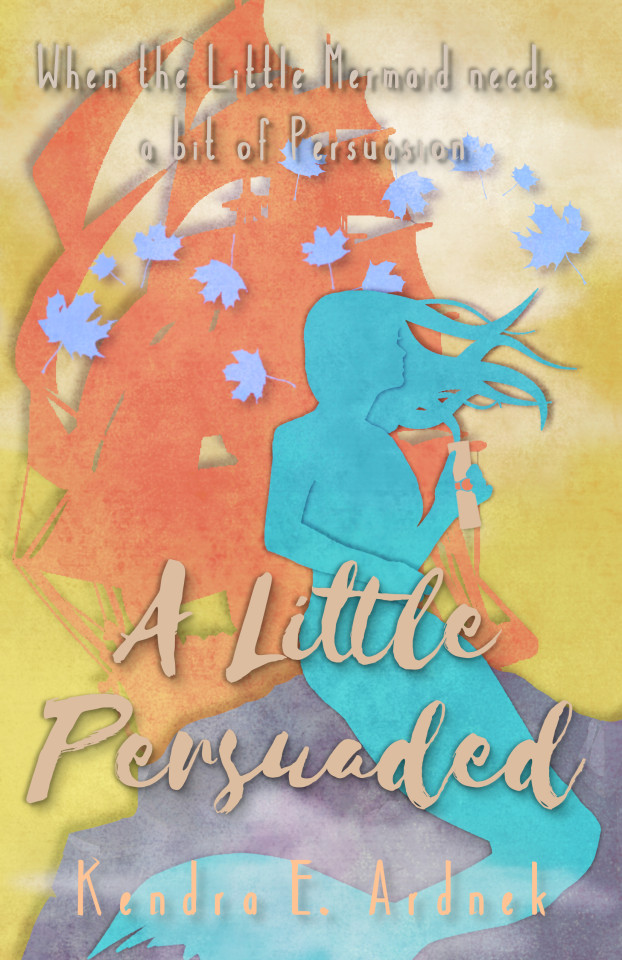
Feels a bit weird to say goodbye to the books that have consumed me for two years straight, but I'm also so excited that these stories can now be read and loved by everyone!
They're all right here. Check 'em out. Also, Thornrose Estate is 99 cents right now for ... reasons.
#Kendra E. Ardnek#my books#books#retellings#austen fairy tale#pride & prejudice#sense and sensibility#Emma#mansfield park#Northanger Abbey#Persuasion#Snow White and Rose Red#Cinderella#Rapunzel#Snow Queen#Beauty and the Beast#the little mermaid
84 notes
·
View notes
Text
An Extended List of Retellings
It was recently Tell a Fairy Tale Day (02/26), so here's an updated and expanded list of retellings for all fairy tale- and folklore-obsessed readers!
*Key at the end of the post*
The Hazel Wood by Melissa Albert (Fairy Tale-esque)
Alice's grandmother is known for her collection of stories that has spawned a cult-like following, spawning plenty of fanatics to follow Alice and her mother around. But this new group is strange, weirder than the rest, and when they take Alice's mother, she must literally dive into the world of her grandmother's stories to save her. (YA, low fantasy)
Damsel by Elana K. Arnold (Fairy Tale-esque)
Ama remembers nothing. All she knows is that she was saved by Prince Emory from a vicious dragon. It seems she will be taken care of for the rest of her life as a pampered princess, but as she learns more about her new home, the more darkness seems to well up around the edges. *read trigger warnings* (NA, high fantasy)
The Frog Princess by E. D. Baker (The Frog Prince)
Princess Emeralda is about to be caught in an unfortunate engagement, but she finds an escape in a talking frog. A frog who claims he is a prince, a perfect excuse to escape a betrothal. What she doesn't expect is being turned into a frog herself with no clue how to change both of them back. (MG, high fantasy)
The Wide-Awake Princess by E. D. Baker (Sleeping Beauty)
Princess Gwen was tragically cursed to fall into a magical sleep, so when her younger sister, Annie, is born, she is given only one christening gift—the ability to resist any magic. When the curse comes true and Gwen falls asleep, Annie sets out to find her sister's true love and wake the kingdom again. (MG, high fantasy)
Peter and the Starcatchers by Dave Barry and Ridley Pearson (Peter Pan)
From an orphanage in London, Peter and his mysterious friend, Molly, arrive at a faraway island. There, pirates and adventures abound, but nothing is as exciting as a precious new substance that can cure wounds, give flight, and keep people young forever. (MG, low fantasy)
The Looking Glass Wars by Frank Beddor (Alice in Wonderland)
When Wonderland, land of dreams and imagination, undergoes a bloody coup, Princess Alyss Heart is forced to flee to the real world, taking on the name Alice Liddel. Years later, she is needed to win Wonderland back, but is it time for Alyss' imagination to be saved? (YA, low fantasy)
The Sisters Grimm by Michael Buckley (multiple)
Sabrina and Daphne Grimm have bounced from foster home to foster home before their formerly-unknown grandmother takes them in. She seems like everything two children could want, but Sabrina doesn't trust her. Not only does she serve outlandish foods and have an outrageous amount of locks on her house, but she seems to believe their town is full of fairy tale characters, all with mysteries that need solving. (MG, magical realism)
The School for Good and Evil by Soman Chainani (multiple)
Agatha and Sophie are best friends, but they couldn't be more different. Agatha is ugly and unpleasant and Sophie is pretty and kind, so when they're taken to the School for Good and Evil, it seems obvious who's Good and who's Evil. However, when the girl's places are switched, they must put things to rights. (MG/YA, high fantasy)
To Kill a Kingdom by Alexandra Christo (The Little Mermaid)
Lira is a vicious siren, known for her collection of prince's hearts. However, a serious mistake of hers leads the Sea Queen to transform her into a human, trapped until she can bring her the heart of Prince Elian. Lira is a practiced killer, but Elian is a trained hunter, and sirens are his prey of choice. (YA, high fantasy)
The Land of Stories by Chris Colfer (multiple)
Alex and Conner have had it rough since their father's death, but they find comfort in their grandmother's book of stories. When she leaves it to them on their birthday, they never expected for it to be a portal to another world. This world is full of all the fairy tales they know and love, but they're trapped there, and ways back are hard to come by. (MG, low fantasy)
Legendborn by Tracy Deonn (King Arthur)
In an attempt to move on after her mother's death, Bree attends an early college program. However, she starts to see things, things her friends can't, and she soon discovers a secret society on campus made up of the descendants of King Arthur and the Knights of the Roundtable. However, this group, the Legendborn, may be tied to Bree more than she knows. (YA, magical realism)
Midnight Robber by Nalo Hopkinson (Caribbean and Yoruba Mythology)
In a futuristic world modeled off of Afro-Caribbean history and mythology, criminals are sent to the world of New Half-Way Tree. No child has been sent before until Tan-Tan is taken by her father, who is on the run from the law. When Tan-Tan's experience takes a turn for the worse, she finds strength the figure of the Robber Queen from myth. *read trigger warnings* (adult, science fiction/fantasy)
Splintered by A. G. Howard (Alice in Wonderland)
Alyssa is a descendant of the famous Alice Liddel, but it's not all roses and tea parties. Madness runs in the family, and Alyssa has heard bugs and flowers speak to her since she was young. It's only when she's a teenager that she learns it's a curse, and the only way to free her family from it is to return to Wonderland and put the original Alice's mistakes to rights.
Stain by A. G. Howard (very loosely The Princess and the Pea)
Princess Lyra is destined to bring her kingdom, one of perpetual day, and their rival, a kingdom of perpetual night, together. However, when her wicked aunt steals her identity and casts her out, she loses her memories and is taken in by a witch from an enchanted forest. There, she lives in disguise, known as a young boy named Stain. (YA, fantasy romance)
Enchanted by Alethea Kontis (The Frog Prince)
Sunday is the seventh daughter of a seventh daughter, a powerfully magic number. Anything Sunday writes comes true, so she takes care to only write what has already happened. She finds someone to share those stories with in a talking frog near her home. Little does she know that the frog is an enchanted prince; specifically, the prince responsible for the death of her older brother.
Ella Enchanted by Gail Carson Levine (Cinderella)
Ella was given a gift at her birth from a fairy, but it's done nothing but make her life miserable. Forced to obey every direct order, Ella loathes her gift of obedience, especially when she is forced to deal with a demanding father and a horrible stepfamily. Ella takes it upon herself to track down the fairy who 'blessed' her with some help from her family's cook, Mandy, and the charming Prince Char. (MG, high fantasy)
Fairest by Gail Carson Levine (Snow White)
Aza is by no means the fairest of them all, but she has the unique gift to imitate others and throw her voice. In the kingdom of Ayortha, which values song above all else, it's an invaluable trait. One the new queen of Ayortha, Queen Ivi, plans to capitalize upon. Ivi lacks singing talent, so she hires Aza to help her deceive the kingdom, but how long can they keep up the charade? (MG, high fantasy)
The Princess Tales by Gail Carson Levine (multiple)
Six stories: The Fairy's Mistake (Diamonds and Toads), The Princess Test (The Princess and the Pea), Princess Sonora and the Long Sleep (Sleeping Beauty), Cinderellis and the Glass Hill (Cinderella), For Biddle's Sake (Rapunzel), and The Fairy's Return (The Golden Goose) (MG, high fantasy)
Ash by Malinda Lo (Cinderella)
Abused by her horrible stepmother, Ash finds solace in stories. Those stories seem to come to life when she encounters a faerie, and her wishes of being stolen away may finally be granted. However, Ash begins to doubt that course when she meets the king's huntress and she finds herself torn between two worlds. (YA, fantasy romance)
Unhooked by Lisa Maxwell (Peter Pan)
Gwendolyn has always thought her mother was crazy for thinking monsters were chasing them, but then she and her best friend are kidnapped. The place they're taken to, Neverland, is full of deception, and Gwen must find out how to get them both home and whole again. (YA, low fantasy)
Cinder by Marissa Meyer (Cinderella)
Cinder is a cyborg in a futuristic world ravaged by sickness and prejudice, but she scrapes by as a mechanic. One day, during a job for no one other than the prince, she discovers information that could tip the balance between the people of earth and the dreaded Lunars. (YA, science fiction)
The Squire's Tales by Gerald Morris (King Arthur)
A series retelling the tales of the Roundtable, beginning with Terence, an orphan who becomes squire to the famous Sir Gawain. Together, they must foil a plot against King Arthur as Terence discovers his own abilities. (MG/YA, historical fantasy)
Uprooted by Naomi Novik (Beauty and the Beast)
Agnieszka is forfeited by her village to the wizard known as the Dragon in exchange for his protection against the horrible Wood. She finds herself more of an apprentice than a servant, but the Wood is stirring, and it's up to her and the Dragon to drive it back. (NA, high fantasy)
Spinning Silver by Naomi Novik (Rumpelstiltskin)
Miryam has brought her family's moneylending business back from the brink of bankruptcy. All is going well until an ill-timed boast on the roads lures the attention of the king of the Staryk, fae-like creatures made of winter and obsessed with gold. But there's a bigger threat that threatens to consume humans and Staryk alike. (NA, high fantasy)
Queen of Hearts by Colleen Oakes (Alice in Wonderland)
Dinah has trained her whole life to become queen of Wonderland alongside her father, finally earning his love. However, out of the blue, her father brings home her half-sister, his illegitimate daughter. With conspiracies brewing, Dinah must hold onto her throne now that another candidate has entered the picture. (YA, high fantasy)
The Girl Who Fell Beneath the Sea by Axie Oh (Shim Cheong)
As their home is ravaged by storms and floods, the people of Mina's village sacrifice a young girl every year, hoping she may be the "true bride" of the sea god. One year, the offered girl is Shim Cheong, Mina's older brother, Joon's, beloved. In an effort to save her, Mina throws herself into the sea to find a fantastical world under the surface. (YA, historical fantasy)
Dorothy Must Die by Danielle Paige (The Wizard of Oz)
Amy is a friendless teenager from modern-day Kansas, so a surprise trip to the land of Oz would seem like a blessing. But this version of Oz is twisted, dark, and ruled by none other than the other girl from Kansas, Dorothy herself. (YA, low fantasy)
The Shadow Queen by C. J. Redwine (Snow White)
Lorelai is the crown princess, but she's also a fugitive. Ever since her kingdom was taken by a wicked queen, she and her brother have been forced to run for their lives. She and the queen share one quality, magic, but if Lorelai ever uses it, she'll be guiding the queen straight to her. (YA, high fantasy)
The Blood Spell by C. J. Redwine (Cinderella)
Blue is an aspiring alchemist, hoping to turn other metals into gold to help the people of her city. However, when her father tragically dies and a cruel woman seizes everything Blue knows, she has to turn to her childhood rival, Prince Kellan. Kellan has his own issues, such as a growing pressure to marry, but the worst is the disappearances that seem to rise in number every day. (YA, high fantasy)
Half Upon a Time by James Riley (multiple)
Jack the 13th is supposed to be a hero, save a princess. He thinks that isn't likely to happen until a 'princess' from our world literally falls into his arms. Soon, Jack realizes that this girl's grandmother can be none other than the famous Snow White, but she's been kidnapped, and it's up to Jack and the 'princess', Meg, to save her. (MG, low fantasy)
The Evil Queen by Gena Showalter (Snow White)
Everly lives the life of a normal teenager until she discovers she's not of this world. In this other land of magic, she's a part of a prophecy, one that mirrors the classic tale of Snow White. That would all be great if she weren't destined to become the story's villain, the Evil Queen. (YA, low fantasy)
Daughter of the Moon Goddess by Sue Lynn Tan (Chang'e)
Xingyin's mother, Chang'e has been imprisoned on the moon for years for stealing the Celestial Emperor's elixir of immortality. When Xingyin's magic flares and she is in danger of being discovered, she must flee the moon. She ends up in the Celestial Kingdom, where she works her way up, hoping to find a way to free her mother. (NA, high fantasy)
Breadcrumbs by Anne Ursu (The Snow Queen)
The Snow Queen made a mirror meant to show people the worst in the world, and when it shatters, a shard gets stuck in the eye of Hazel's best friend Jack. When the Snow Queen whisks him away, Hazel must travel through a treacherous, wintery forest to save him. (MG, low fantasy)
Malice by Heather Walter (Sleeping Beauty)
Alyce is the infamous Dark Grace, whose powers bring curses and misfortune, unlike her sisters, who can conjure gifts and beauty. She dreams of escaping the prejudiced Kingdom of Briar, but her growing powers and an involvement with the royal family could keep her trapped forever. (adult, fantasy romance)
KEY
MG: middle grade, ages 8-12
YA: young adult, ages 13-18
NA: new adult, ages 18-early twenties
adult: ages 18 and up
high fantasy: fantasy stories set entirely within another world
low fantasy: fantasy stories split between our world and another
magical realism: fantasy stories set in our world, often interwoven with aspects of modern life (not the Latin American literary movement!)
historical fantasy: fantasy stories set in a historical setting of our world
fantasy romance: fantasy stories focused on romantic plotlines instead of other forms of plot
#books#recommendations#fairytales#retellings#the hazel wood#the frog princess#peter and the starcatchers#the sisters grimm#the school for good and evil#the land of stories#to kill a kingdom#legendborn#splintered#stain#ella enchanted#fairest#uprooted#spinning silver#malice#daughter of the moon goddess
286 notes
·
View notes
Text
Once you know that Marissa Meyer based The Lunar Chronicles (and specifically Cinder, the first book) on an old Sailor Moon fanfic she wrote, the inspiration can be fairly obvious (most obvious being the missing princess from the moon and the threat of war between Earth and the Moon). That being said, there’s enough of Meyer’s own inspiration/ideas in there to help make it stand out (the futuristic setting, for one thing).
But it did make me think: Bill Ellis (who I mentioned on here before) wrote an essay about Princess Tutu where he said that Cinderella--the fairy tale Cinder retells--is an archetypal precedent to magical girl transformations. Cinderella and Sailor Moon have premises unique to themselves, but then I thought about the basics of both stories: both Cinderella and Usagi start out as girls who are at a low point of their life (Cinderella is mistreated by her stepfamily, while Usagi is chronically late for school and failing tests--one is arguably worse than the other, sure, but the point is, neither of them is doing great in their own way). Then both of them encounter magic (fairy godmother, talking space cat, etc.) that gives them, as Ellis puts it, the skills they need to accomplish whatever they need to do (go to the ball, fight evil). For an added bonus, no one at the ball ever recognizes Cinderella, similar to how no one ever puts it together that Usagi is Sailor Moon, despite her never covering her face (though she did have a mask in the early chapters of the manga). Also, there’s a prince in both stories.
With that in mind, it’s not hard to see how it was easy for Meyer to take inspiration from Sailor Moon in her Cinderella retelling. (Interestingly enough, the original fanfic was a Puss in Boots AU, because as Meyer pointed out, both Puss in Boots and Sailor Moon have talking cats.)
#the lunar chronicles#cinder#sailor moon#bishoujo senshi sailor moon#usagi tsukino#linh cinder#marissa meyer#naoko takeuchi#cinderella#charles perrault#magical girl#magical girls#fairy tales#retellings#bill ellis#princess tutu#random thoughts#text#I don't know if I ever specified on here#but I am a Sailor Moon fan#just finally got around to watching the new adaptations
212 notes
·
View notes
Text

For some reason yesterday it seemed really important to draw naked kissing instead of getting any actual work done. But look! I drew her hands totally without reference. Actually I drew most of this without photo reference (I did use ref for his head angle), which means it took me hours (this sketch is my third attempt) but I think it was time well spent because I learned a few things :)
#beauty and the beast#monster boyfriend#fairytale retelling#book characters#monster romance#retellings#fantasy illustration#fantasy art#ekbelsher
578 notes
·
View notes
Text
romeo and juliet modern retelling where instead of poison juliet jumps off a cliff and then romeo follows her but she actually had a hidden parachute so there's the split second where they're looking at each other and then she opens the parachute while he keeps falling. and post.
#romeo and juliet#shakespeare#classic literature#dark academia#modern retelling#retellings#vampireposting
60 notes
·
View notes
Note
Hello! I was wondering if you knew when any more of the remixed classics series might be coming out, or if there’s other upcoming lgbt retellings of classics?
Thank you so much for your time and energy, I appreciate it !!
Oh I love that series so much <3 I don't know when more are coming out but I do know at least two more have sold - K. Ancrum will be doing Frankenstein (and though it's not part of the series, she also has an lgbt retelling of the Icarus myth out next week called Icarus that looks amazing), and Alex Brown will be doing Dracula - that's the most recently announced one and it'll be called Renfield, at least for now. (If you're interested in more Greek mythology retellings, hit me up again, because there are a few coming soon.)
As for others, I recently loved Lev Rosen's Emmett and there's a new Emma retelling done as a graphic novel coming in September called Mismatched: https://amzn.to/491giz5. Rabbit & Juliet by Rebecca Stafford also comes out in September: https://lgbtqreads.com/2024/02/09/exclusive-cover-reveal-rabbit-juliet-by-rebecca-stafford/ and in November, Not for the Faint of Heart by Lex Croucher isn't a retelling, but it's a historical Sapphic romance starring the granddaughter of Robin Hood: https://amzn.to/4cjIy33. In Adult, speaking of Dracula, Kiersten White has Lucy Undying also coming in September (September is very gay this year. Also extremely trans.)
28 notes
·
View notes
Text
If the Asian and Egyptian versions of the Cinderella story really are the oldest versions, then it's very interesting to see how the story of Cinderella has done an about-face between those early versions and the most recent adaptations.
In the Egyptian tale of Rhodopis, the Chinese tale of Ye Xian, and the Vietnamese tale of Tam and Cam (among others, I'm sure), the heroine and the king she ultimately marries don't meet before she loses her shoe. He just finds the shoe, or some other person or animal finds it and brings it to him. He determines from how small and delicate it is that it must belong to a very beautiful woman, so he resolves to find her and marry her, and he does.
These early proto-Cinderellas and their kings don't have time to fall in love before they get married, unless we assume that love at first sight takes place. The point isn't that she finds true love: the point is that she escapes from her unhappy circumstances, marries a king, and becomes a queen. It makes sense that it should be that way, since in those cultures (and most others) in ancient times, marriage was probably very rarely for love. The heroine's escape and social advancement are the central wish-fulfillment.
But as the tale travels to Europe and becomes the familiar Cinderella, it changes. The heroine and her prince (as he tends to be in European versions instead of a king) now meet at the ball or festival she attends in her magic finery. They fall in love there. The search for the girl who fits the slipper isn't just for a girl presumed to be beautiful based on the smallness and daintiness of her shoe, but a search for the girl the prince already loves yet has no other way to find.
The central wish-fulfillment changes from just "the heroine escapes from abuse and marries into royalty" to "the heroine finds true love, escapes from abuse, and marries into royalty."
Stage and screen adaptations from the 19th century onward often take this change a step further, probably both to increase the romanticism and to prevent anyone from accusing Cinderella of being a gold-digger. They have Cinderella fall in love with the prince without knowing he's a prince, and only learn his identity later. The fact that he is royalty comes across as just an added bonus for this Cinderella, who was perfectly content thinking she had found a poor but loving man.
And now, in the 2020s, a new trend has emerged in adaptations. In no less than three recent Cinderellas – Andrew Lloyd Webber's 2021 musical, the 2021 Amazon/Sony Pictures movie musical, and the 2020 storybook Sootypaws that retells the story with mice – the heroine and her prince fall in love, but they don't get married and she doesn't become royalty. On the contrary, falling in love with Cinderella makes the prince realize he doesn't want to be king after all, so he abdicates his throne, letting his convenient brother or sister reign instead, and the two lovers set out to travel the world together.
The theme of the heroine escaping from abuse is consistent. But when it comes to what else she gains, we've shifted from "the heroine marries into royalty" to "the heroine finds true love and marries into royalty," to just "the heroine finds true love," and with added emphasis on gaining freedom.
This change probably says a lot about the difference between today's Western culture and the cultures of ancient Egypt or China.
123 notes
·
View notes
Text
ACOTAR 5: A Frozen and Moana Retelling
By @wingedblooms and @silverlinedeyes
Note: this is mainly a joke based on @wingedblooms amazing Ramiel meta and we were cracking up at the idea, but Sarah has toddlers so I CAN SEE IT lmao
Cast of Characters
Te Fiti/Arendelle: Wyrd whose soul is in Prythian (the heart of which is in Ramiel)
Ta’ka/the eternal winter: the barren parts of Prythian
The Heart of Te Fiti: the Cauldron
Elsa/Maui: The Asteri (I think? TBD honestly)
Anna and Kristoff/Moana and Maui: Elain and Azriel
Love: well, love (or Elain’s life giving or healing powers)
A Plot Summary
A long time ago in a land far far away (Prythian) Wyrd birthed the land. To give life to the land, her spirit was entrapped in the cauldron, and that cauldron was hidden in the heart of Prythian: Ramiel.

One day, the land was invaded by evil beings called Daglan, though we now know they were Asteri. And the Asteri stole the spirit of Wyrd for themselves and corrupted it.

This corruption caused a plague to ripple through the land, killing mountain after mountain (like how death killed island after island in Moana—see where we’re going here?)

This set off an eternal winter (“you kind of set off an eternal winter”) in Illyria that could only be prevented by the Blood Rite feeding life and magic back into the land to temporarily bring back spring, only for the land to fall into a deep winter again that it seemed could not be broken until the Rite was done anew.

Never fear though! Elain and Azriel are going to go on a journey to figure out what is wrong with the land. They might even have to go to Hel or maybe the Middle (either one would be Lalotai—the land of monsters) and back to find answers.


They will have to face whatever evil lurks within the land, leeching it of life, and whatever evil has corrupted the cauldron.

And ultimately, they will discover that love (or maybe, you know, Elain’s lifesinging magic or healing magic) can thaw a frozen “heart” and remove the corruption from the cauldron (a la Yrene in ToD and KoA using healing powers to remove the Valg parasite?), restoring the heart of Prythian—i.e. the Caudron and Wyrd’s spirit—to the land and cause spring to bloom again.

Oh and how could I forget—Elain and Az will discover true love (true mates?!) for each other along the way.

THE END.
#you’re welcome 🤣🤣
#acotar5#elriel#Ramiel#Elain#azriel#only love can thaw a frozen heart#restore the heart of te fiti ie Ramiel#Moana#frozen#retellings#we crack ourselves up#you’re welcome
28 notes
·
View notes